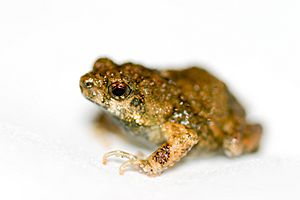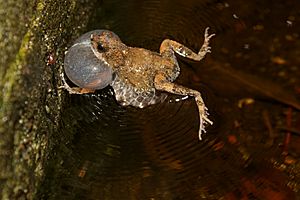Túngara frog facts for kids
Quick facts for kids Túngara frog |
|
|---|---|
 |
|
| Conservation status | |
| Scientific classification | |
| Synonyms | |
|
The Túngara frog (Engystomops pustulosus) is a small type of frog that belongs to the family Leptodactylidae. These frogs are active at night and live on land. You can find them in Mexico, Central America, and the northern parts of South America.
Túngara frogs have cool ways of finding a mate. Male frogs make special calls to attract females. Females often like males who make complex calls that sound deeper, rather than simple, higher-pitched calls. These calls are super important for mating and are made using a special part in the frog's throat. Túngara frogs might even have a helpful friendship with tarantulas! The tarantulas might protect the frogs from danger, and in return, the frogs might guard the tarantula's eggs. Túngara frogs also have unique colors that help them hide from animals that want to eat them.
Contents
What the Túngara Frog Looks Like
The Engystomops pustulosus is a small frog that lives on land. It grows to be about 1 to 1.4 inches (25 to 35 mm) long. The frog's eardrum, called the tympanum, is hard to see. Its back, or dorsum, is covered in small bumps that look like warts. Because of these warts, people used to think túngara frogs were a type of toad.
Túngara frogs have big, bulging eyes. Male frogs have large, dark pouches under their chin called vocal sacs. These sacs puff up when they call to attract females. Both male and female frogs usually have a clear white stripe that goes from their lower lip down their throat.
Where Túngara Frogs Live
You can find the túngara frog in Mexico and all through Central America. They also live in northern South America, reaching as far east as Trinidad and Tobago, Venezuela, and possibly Guyana.
These frogs live in many different places. Their natural habitats include dry forests, savannas, grasslands, and marshes. They can also be found in places changed by humans, like pastureland, old forests, ponds, and canals.
What Túngara Frogs Eat and How They Live
Túngara frogs are nocturnal, meaning they are active at night. They come out to eat ants and termites. They also munch on other small creatures like snails, beetles, flies, and isopods. They find their food among the plant litter on the ground.
During the time when they mate, male frogs gather at night in temporary pools of water. They call loudly to attract female frogs. When a female chooses a male, they mate at the water's edge. The male then creates a special foam nest where the eggs are laid. The tadpoles grow in the water and change into young frogs in about four weeks.
Mating and Reproduction
Mating Calls
The main way túngara frogs attract mates is by making loud calls that can be heard from far away. These calls have two main parts: a 'whine' and a 'chuck'. Male frogs always start with a whine. They can then add up to seven short 'chuck' sounds. A call with both a whine and chucks is called a complex call.
The 'chuck' sound is made by a special part in the frog's throat near its larynx. Bigger parts allow the frog to make more chucks. The 'whine' is a long, changing sound. The 'chuck' is a short, loud burst of sound. The 'whine' helps females know it's a túngara frog and guides them. The 'chuck' makes the call much more attractive for mating.
The frog's larynx and a special fibrous mass help make these sounds. When the frog pushes air from its lungs, it vibrates these parts, making the sound. Air then goes into the frog's mouth and inflates its vocal sac. This puffed-up sac also helps females see the calling male. Male túngara frogs that make chucks have a larger fibrous mass than other frogs. If this part is removed, they can't make the chuck sound, even if they try.
How Females Choose a Mate
Female túngara frogs are very picky about which male they choose. They prefer complex calls over simple calls. They also like deeper (lower frequency) chucks more than higher-pitched ones. And they prefer the whine of their own species over other frog species.
Females like lower-pitched chucks because they are closer to what their ears hear best. This means they get a stronger signal from these calls. Females also prefer lower-pitched chucks because larger males make these sounds. Larger males are better for reproduction because they can help fertilize more eggs. Male frogs grow a larger larynx as they get older, which helps them make these deeper sounds.
Scientists have done experiments to see what calls females prefer. They put a female frog between two speakers playing different calls. Females strongly preferred calls with a 'whine' and a 'chuck' over just a 'whine'. They also preferred calls with low-pitched chucks. This shows how important these specific call features are for mating.
Male Frog Interactions
Making complex calls helps male frogs find mates, but it also has a downside. Predators like frog-eating bats and blood-sucking flies prefer complex calls. These predators use the calls to find and eat the male frogs. So, male frogs sometimes switch between complex and simple calls depending on the situation.
Male frogs make complex calls more often when other males are calling nearby. This group calling is called a chorus. By calling together, males increase their chances of finding a mate while also reducing their individual risk of being eaten. When a male frog is alone, he usually makes simple calls. But when he joins a chorus, he makes more complex calls.
Research shows that the size of the chorus affects the risks and benefits. In a larger chorus, there's a better chance of finding a mate, and the risk of being eaten by a predator goes down for each frog. If a predator shows up, an individual frog has a lower chance of being attacked if there are many other frogs around.
Life Cycle
When male túngara frogs gather in choruses and call, female frogs move through the group to choose a mate by touching them. During mating, the male sits on top of the female. He helps mix a special liquid released by the female to create a floating foam nest. These nests are strong and protect the fertilized eggs. After about four days, the tadpoles leave the nest, and the nest slowly breaks down. However, it can last for up to two weeks.
Relationships with Other Animals
It's been reported that the túngara frog might have a helpful relationship with tarantulas in Mexico. This is a type of mutualism, where two different species help each other. Just like some other small frogs and tarantulas, the spider might protect the frog from predators. In return, the frog might protect the spider's eggs from ants.
Protective Coloration and Behavior
Some of the main animals that hunt túngara frogs include bats, other frogs, opossums, and crabs. To protect themselves, túngara frogs have different color patterns depending on where they live. They have two main patterns: unstriped and striped.
The number of striped frogs changes depending on how urbanized an area is. In cities, there are more striped frogs than in forests. Striped frogs are more common in city areas where birds are a big threat. Frogs in forests get attacked less by birds. Scientists are still studying how different things, like the types of predators in an area, affect the frog's colors. Their protective colors will keep changing based on these factors.
Conservation Status
The IUCN Red List helps track how much danger different animals are in. The Túngara frog is listed as "Least Concern". This means it's not currently at high risk of disappearing.
However, amphibians like the túngara frog are among the most threatened animals. At least 43% of amphibian species are declining. The biggest problems for amphibians are losing their homes (habitat loss), pollution, climate change, and new species that invade their areas.
Habitat loss and pollution are the most serious threats. When farms and cities grow, they destroy frog homes and release more pollution. Scientists are still learning how these changes affect the health of amphibians, including the túngara frog.
Some studies show that living near farms can harm túngara frogs. They might lay fewer eggs, have fewer eggs hatch, and the young frogs might be smaller. These findings are important for protecting amphibians, because fewer babies mean fewer frogs in the future. More research is needed to fully understand this connection.
See also
 In Spanish: Rana túngara para niños
In Spanish: Rana túngara para niños



